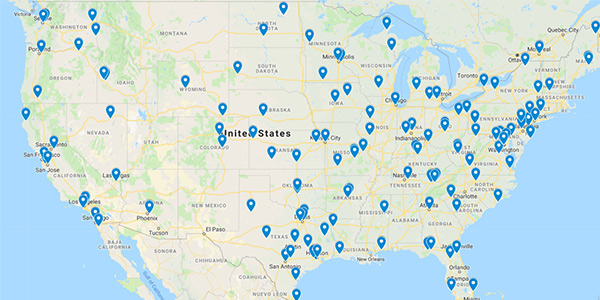By Rich Heidorn Jr.
Grid operators and generators need more granular, real-time data to respond to grid oscillation events, engineers on a NERC panel said last week.
Tim Fritch, Tennessee Valley Authority manager of reliability analysis, last week gave the Operating Reliability Subcommittee (ORS) new details on the Jan. 11 oscillation event, when a “misbehaving” steam unit in Florida sent the Eastern Interconnection rocking like an unbalanced washing machine for 18 minutes. The presentation was an update of one that Fritch, vice chair of the Synchronized Measurements Subcommittee (SMS), gave to the ORS in the spring. (See Panel: Action Needed in Response to Oscillation Event.)
It was at least the sixth such event since 1996, according to a NERC reliability assessment published in July.
In the January event, Fritch said, the plant operators knew their unit was malfunctioning but “didn’t know they were moving the grid.”
One of the voltage signals used for the power load imbalance controller was compromised and 30% below what it should have been, Fritch said. “So, the controller was opening and closing the inverter valve on the unit. And this was causing a local area oscillation at about 0.25 Hz. This excited a natural mode that we had identified in previous studies that was around 0.23 to 0.24 Hz. So, since the unit was oscillating at 0.25, it was exciting this natural mode that was in turn causing this resonance phenomenon.”
The resonance was felt from Florida to the Midwest and New England, with power swings of 200 MW around Florida and 50 MW around ISO-NE.
Fritch said the event highlighted the need for better diagnostic tools and training in what not to do in such events.
“If you take some units offline for these types of events, we know it could get worse,” Fritch said. “Units act as a shock absorber on the system to absorb some of the energy from these big grid oscillations. So, taking some units down could make it worse.”
Fortunately, the only unit taken offline was the Florida unit that caused it. But other utilities considered taking their units down or shutting off automatic generation control (AGC), Fritch said.
Need for Better Tools
Fritch said TVA and other utilities with oscillation detection tools can only see their own footprint. “This happened for a lot of utilities on the Jan. 11 event: We knew it was big because all of our oscillation tools went into alarm. It showed our PMUs [phasor measurement units] were seeing this oscillation. But we couldn’t see outside of our footprint,” he said.
“We’re pretty good at identifying when we have a local oscillation based off our oscillation tools. But when you have these big grid oscillations where you excite these natural modes, you need more visibility.”
TVA was one of the two utilities that took its generators off AGC. “We thought our units were misbehaving. It’s hard to tell sometimes whether you’re the leader or the follower of these events.”
Of 11 utilities that responded to a NERC survey about the event, seven agreed there is a need to develop both a PMU data-sharing requirement for reliability coordinators and a real-time regional oscillation and source detection tool. The same number agreed the SMS should identify and address gaps in existing reliability standards on RC-to-RC coordination.
Fritch noted Professor Yilu Liu, of the University of Tennessee at Knoxville, helped create a video visualizing the oscillation using FNET/GridEye, a GPS-synchronized, wide-area power system frequency measurement network that uses data from more than 200 frequency disturbance recorders — essentially PMUs — around the world.
“Maybe there’s an opportunity to make that a real-time application instead of a post-op,” Fritch said, adding the industry may need to increase the number of recorders. “In my mind, there’s not enough to give you great granularity down to the unit,” he said.
“That’s why the industry, with like the [Department of Energy’s] ESAMS [Eastern Interconnection Situational Awareness Monitoring System] program, has been looking at bringing all of the PMU data into some type of tool because it has much greater coverage than the frequency disturbance recorders that FNET uses.”
Thousands of PMUs were installed across North America in the last decade. ESAMS is using their data “and looking for these types of events to see how [they’re] affecting the grid and help identify the cause of the forced oscillation that’s exciting these natural modes.”
Training Needs
Chris Wakefield, of reliability coordinator Southern Company Services, said some plant operators in his company’s footprint thought their control systems were malfunctioning during the oscillation. “They were [ready to take] action — taking their units off AGC or doing something more drastic, like a nuclear plant may go into some type of protective mode,” he said. “How do you communicate to generator operators that that’s not probably what you want them to do?”
Fritch said there’s no “cookie cutter answer” but training would help.
“Maybe it’s coming up with better communication between generation owners and RCs for these types of events,” he said. “That’s something we need help with from the ORS and from the industry.”
Next Steps
NERC will hold a webinar 2-3:30 p.m. ET on Friday to discuss the Jan. 11 event and the recently published Interconnection Oscillation Analysis report on the oscillatory behavior of the Western, Texas and Eastern Interconnections.
“I feel like we’re headed in the right direction. It seems like … the consensus is that NERC believes there needs to be some type of tool or application and guidance on how to handle these in the future,” Fritch said. “I know what we experienced was bad, but it could have been worse if those forced oscillations, instead of being 0.25, were around 0.23 or 0.24, or the unit was bigger. This was a 25-MVA unit. What if it were a 1,000-MVA nuke plant that was doing this?”





